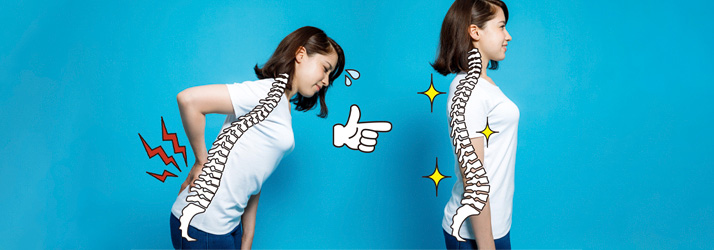KST & The Posture Of Subluxation in Burbank CA

A subluxation is a distortion in your body that interferes with your flow of energy and information. Subluxations interfere with internal communications, inner harmony and healing. Koren Specific Technique (KST) quickly locates and releases subluxations in Burbank CA, permitting your body/mind to function at a higher level of efficiency, harmony, communication, and health.
Revealing the Subluxation in Burbank CA
A subluxation often reveals itself when you are in a posture of musical (or emotional) injury, pain and/or dysfunction. The subluxation is most amenable to location and correction when you are in that posture.
Years ago, Dr. Lowell Ward of Long Beach, California had a patient who felt fine standing, but had head, back and sciatic pain while seated. Standing x-rays showed a balanced, unsubluxated spine. He wondered, "What would I find if I x-rayed her in the seated posture?" Her seated films revealed an unbalanced, subluxated spine. No wonder she hurt when she was sitting! Dr. Ward asked the question "Am I missing other subluxations by limiting my analysis to one posture?"
Dr. Ward's subsequent research revealed that one posture could show severe subluxations while another would not. For example, a person injured while seated (as in a car accident) would show subluxations and distortions only in a seated position and little if any subluxation damage standing. Similarly, a person injured while playing spots or falling down stairs would reveal subluxation damage when standing spine and relatively healthy seated spine.
Most interesting was that the x-ray could reveal the dynamics of the accident. For example, an accident victim thrown forward and to the left would reveal a spine with the head off-center to the left and forward.
Make It Hurt - Positional Adjusting
One of the advantages of Koren Specific Technique (KST) is that it permits the practitioner to check (or analyze) and correct (or adjust) a patient in any posture. That's why KST doctors may not use an adjusting table when they correct your subluxations.
Patient: "Doctor, it hurts when I do that."
Doctor: "Don't do that."
The above Henry Youngman joke notwithstanding, we always ask the patient to "do that", that is, assume a posture of pain/dysfunction/subluxation. "Make it hurt", we tell them. "Bring out the subluxation causing your problems."
We then check and correct (adjust) the patient in the posture of subluxation. The result is a more completely adjusted patient with a healthier spine, healthier body structure and healthier nervous system.
The Possibilities Are Endless
How does this work in an office? A person who only hurts or has trouble when turning a certain way is told to "freeze" and then is checked in that position and corrected (adjusted).
For example, a person who hurts when they hold a gulf club in a certain position is checked for subluxations and adjusted while in that position (preferably holding a golf club). A guitarist who only hurts when holding the guitar could be checked and adjusted in the position of holding the guitar or actually holding one.
A writer who only hurts when holding the mouse at a certain angle should be checked and adjusted while in the position of holding the mouse at that certain angle. A person who was subluxated when they hit their head in a cramped, stooped position would best reveal their subluxation when in a cramped, stooped position, in other words, the posture of injury.
The positions are endless.
Emotional Subluxations
It is perhaps no accident that the word posture can refer to an emotional as well as physical stance. Just as a patient may place himself or herself in a certain physical posture and then be checked for subluxations, a person may put themselves in a certain emotional posture and then be checked.
"Think about the car accident, see the road, smell the car, be in the accident, ok, now hold that thought or picture."
Patients can be checked and corrected while reliving an accident or thinking about a lost loved one, a difficult relationship, a life crisis - the possibilities are endless. It appears that when receiving an adjustment in that emotional state, a mind/body reflex is interrupted.
How does this care help patients?
Old, chronic subluxations that were buried away and not amenable to correction before are finally located and corrected (or released). We can locate that cause of the patients subluxations faster, adjustments hold longer and patients are much happier with the results. We personalize patient care.
We tailor each visit to the patient's specific needs and life experience; they are not treated the same way each visit. In order to adjust a person who is standing or sitting with their arm, head, neck, shoulders or other body part in a particular position, we use an adjusting instrument.
Koren Specific Technique
Koren Specific Technique is a quick, easy, gentle technique used to locate and correct subluxations anywhere in the body while the patient assumes any (physical or emotional) state or posture. With KST the practitioner is able to check and correct (adjust) the entire structural system, including the cranial bones.
KST patients hold their adjustment longer; healing goes deeper (retracing is often observed). KST's light force is comfortable for patients; children and the elderly especially like KST's gentle approach.
Monday
10:30am - 6:00pm
Tuesday
10:30am - 6:00pm
Wednesday
10:30am - 6:00pm
Thursday
10:30am - 6:00pm
Friday
10:30am - 6:00pm
Saturday
10:30am - 4:00pm
Sunday
Closed
First Chiropractic
101 W Alameda Ave
Burbank, CA 91502
